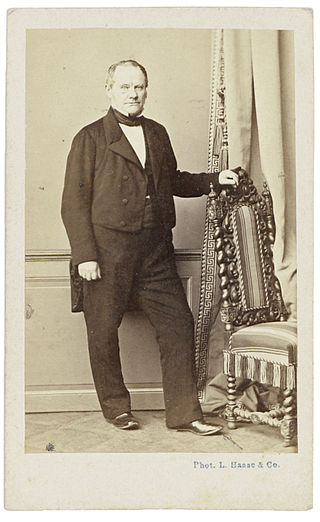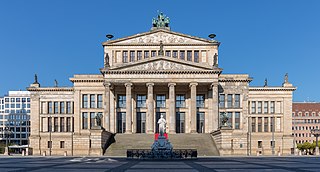
Karl Friedrich Schinkel was a Prussian architect, city planner and painter who also designed furniture and stage sets. Schinkel was one of the most prominent architects of Germany and designed both Neoclassical and neo-Gothic buildings. His most famous buildings are found in and around Berlin.

The Altes Museum is a listed building on the Museum Island in the historic centre of Berlin, Germany. Built from 1825 to 1830 by order of King Frederick William III of Prussia according to plans by Karl Friedrich Schinkel, it is considered as a major work of German Neoclassical architecture. It is surrounded by the Berlin Cathedral to the east, the Berlin Palace to the south and the Zeughaus to the west. Currently, the Altes Museum is home to the Antikensammlung and parts of the Münzkabinett. As part of the Museum Island complex, the Altes Museum was listed as a UNESCO World Heritage Site in 1999, because of its testimony to the development of museums as a social and architectural phenomenon.

Friedrich Drake was a German sculptor and medallist, best known for his huge memorial statues.

August Karl Eduard Kiss, or Kiß was a German sculptor, known for his monumental bronzes.

Glienicke Palace is a historic palace located on the peninsula of Berlin-Wannsee in Germany. It was designed by Karl Friedrich Schinkel around 1825 for Prince Carl of Prussia. Since 1990, Glienicke Palace and the park have been part of the UNESCO World Heritage Site "Palaces and Parks of Potsdam and Berlin" because of their unique contribution to Prussian landscape architecture.

The Bauakademie in Berlin, Germany, was a higher education institution for the art of building to train master builders. Founded on 18 March 1799 by King Frederick William III, the institution originated from the construction department of the Academy of Fine Arts and Mechanical Sciences, which emphasized the aesthetic elements of the art of building while ignoring the technical. Thus, the governmental Upper Building Department ("UBD") decided to establish an entirely new building educational institution named "Bauakademie". In 1801, the institution was incorporated into the UBD.

Friedrich August Stüler was an influential Prussian architect and builder. His masterpiece is the Neues Museum in Berlin, as well as the dome of the triumphal arch of the main portal of the Berliner Schloss.

Friedrichswerder Church was the first Neo-Gothic church built in Berlin, Germany. It was designed by an architect better known for his Neoclassical architecture, Karl Friedrich Schinkel, and was built under his direction from 1824 to 1831.

Christian Friedrich Tieck, often known only as Friedrich Tieck, was a German sculptor and a occasional artist in oils. His work was primarily figurative and includes both public statuary and private commissions for portrait busts.

The Konzerthaus Berlin is a concert hall in Berlin, the home of the Konzerthausorchester Berlin. Situated on the Gendarmenmarkt square in the central Mitte district of the city, it was originally built as a theater. It initially operated from 1818 to 1821 under the name of the Schauspielhaus Berlin, then as the Theater am Gendarmenmarkt and Komödie. It became a concert hall after the Second World War, and its name changed to its present one in 1994.

The Prussian National Monument for the Liberation Wars is a war memorial in Berlin, Germany, dedicated in 1821. Built by the Prussian king during the sectionalism before the Unification of Germany it is the principal German monument to the Prussian soldiers and other citizens who died in or else dedicated their health and wealth for the Liberation Wars (Befreiungskriege) fought at the end of the Wars of the Sixth and in that of the Seventh Coalition against France in the course of the Napoleonic Wars. Frederick William III of Prussia initiated its construction and commissioned the Prussian Karl Friedrich Schinkel who made it an important piece of art in cast iron, his last piece of Romantic Neo-Gothic architecture and an expression of the post-Napoleonic poverty and material sobriety in the liberated countries.

Ludwig Wilhelm Wichmann was a German sculptor. He specialized in making portrait busts.

Schlossbrücke is a bridge in the central Mitte district of Berlin, Germany. Built between 1821 and 1824 according to plans designed by Karl Friedrich Schinkel, it was named after the nearby City Palace (Stadtschloss). The bridge marks the eastern end of the Unter den Linden boulevard.

The statue of Albrecht Thaer is a bronze sculpture installed at Schinkelplatz in Berlin, Germany.

Schinkelplatz is a square in Berlin, Germany, named after Karl Friedrich Schinkel.

A bronze statue of Christian Peter Wilhelm Beuth by August Kiss is installed at Schinkelplatz in Berlin, Germany.

The Scharnhorst Memorial on Unter den Linden avenue in Berlin's Mitte district commemorates the Prussian military reformer and freedom fighter Gerhard von Scharnhorst (1755–1813). Created from 1819 to 1822 by Christian Daniel Rauch in neoclassical style, it is a masterpiece of the Berlin school of sculpture.

The Bülow Memorial on Unter den Linden avenue in Berlin's Mitte district commemorates the Prussian army general and freedom fighter Friedrich Wilhelm Bülow von Dennewitz (1755–1816). Created from 1819 to 1822 by Christian Daniel Rauch in neoclassical style, it is a masterpiece of the Berlin school of sculpture.




















